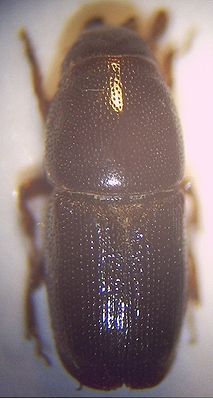Small elm splint beetle
| Small elm splint beetle | ||||||||||||
|---|---|---|---|---|---|---|---|---|---|---|---|---|

Small elm splint beetle ( Scolytus multistriatus ), female, enlarged 40 times. |
||||||||||||
| Systematics | ||||||||||||
|
||||||||||||
| Scientific name | ||||||||||||
| Scolytus multistriatus | ||||||||||||
| ( Marsham , 1802) |
The small elm beetle ( Scolytus multistriatus ) is a weevil from the subfamily of the bark beetle (Scolytinae). Since it creates its breeding systems in the bark of the host trees, it is counted among the bark breeders.
features
The beetles are 2 to 3.5 millimeters long and have a black, cylindrical body. The pronotum is large, narrowed in front, the base and sides are edged. Seen from above, it does not cover the head. In the male beetle, the forehead is flat with a fringe of hair, while in the female beetle it is arched and bald ( sexual dimorphism ). The abdomen rises obliquely from the second sternite towards the end. The rails ( tibia ) of the front legs are smooth on the outside, the tip is curved like a hook. The third tarsal link is bilobed. The red-brown colored wing covers have regular rows of points made of small depressions. The antennae and legs are red-brown.
distribution
The species is widespread in Europe and in the southern and western parts of European Russia.
Way of life
The elm splint beetle occurs mainly on elms ( Ulmus ), occasionally also on quivering poplar ( Populus tremula ), Prunus species, buckthorn ( Rhamnus ), hornbeam ( Carpinus betulus ), alder ( Alnus ), oriental beech ( Fagus orientalis ) , Oak and ash trees . It colonizes the bark of the trees, also in the area of the bark . The feeding pattern is a relatively short, two to six centimeters long, one-armed mother tunnel (vertical longitudinal tunnel). The up to 50 larval ducts on each side branch off to the side. One, rarely two generations are trained each year. The flight time is from late May to June. The beetle eats at the junctions of small branches and at the base of the petioles. In doing so, and when boring into the bark / bark, it transfers spores of the fungus Ceratocystis ulmi . This fungus leads to a disease of the tree, elm disease , which usually leads to the death of the host tree.
Combat
Control is practically impossible because the animals will always have material that is suitable for breeding. Infested trees are usually discovered too late. Foci of infestation must be completely eliminated if one wishes to curb further spread and the bark with the larvae and eggs as well as the infected wood destroyed. In many places, however, the elms have already died on the fungus and are therefore no longer available as host trees. There have been attempts to cultivate Resista elms to resist the fungus.
literature
- Fritz Schwerdtfeger : The forest diseases. Textbook of forest pathology and forest protection . 4th, revised edition. Parey, Hamburg and Berlin 1981, ISBN 3-490-09116-7
- Sabine Green : Manual for the determination of the European bark beetle Verlag M. & H. Schaper, Hanover 1979, ISBN 3-7944-0103-4
- Edmund Reitter : Fauna Germanica - The beetles of the German Empire. Volume 5, KG Lutz, Stuttgart 1916
- Edmund Reitter: Fauna Germanica - The beetles of the German Empire. 5 volumes, Stuttgart KG Lutz 1908–1916, digital library volume 134, Directmedia Publishing GmbH, Berlin 2006, ISBN 3-89853-534-7